Government to Issue Guarantees for New Ships at 3. Maj Shipyard
ZAGREB, March 6, 2020 - The government is prepared, under certain circumstances and strict control, to issue guarantees for 48% of the value of new ships for the Australian Scenic Group that would be built in the 3. Maj shipyard, Economy Minister Darko Horvat said at the Rijeka-based dock after talks with the Scenic Group's owner and the 3. Maj director.
Horvat, Scenic Group owner Glen Moroney and 3. Maj director Edi Kučan discussed the construction of five polar cruise ships with a total value of €860 million.
We consider that the agreement was reached about ten days ago when we accepted the mutual interest of the shipyard and the client to invest in 3. Maj, to rehabilitate the dock and build sophisticated ships, Horvat said.
The government is willing to assist 3. Maj under certain conditions and strict control, and issue guarantees at the ratio 48 to 52 per cent, which the client has agreed to, Horvat explained.
Horvat believes that that is a fair division of responsibility, with strict supervision and pace of construction.
Asked when would that agreement enters into force, he said at the very moment when a request for the first guarantee is received.
For the state, that means the continuation of shipbuilding at 3. Maj, Horvat said.
Asked whether that means the end of the dock's agony, Horvat said that he would not be that optimistic. The state, he said, has done its share and now the dock's management has to do its part.
Asked whether a car transport ship (514) that was to have been built in the Uljanik shipyard in Pula would now end up in 3. Maj, Horvat said that that is something for lawyers to deal with. "Once lawyers come to an agreement over the methodology, then the government will give its consent," he said.
He underscored that the bailout of 3. Maj has been planned on the basis of three ships being completed, which includes ship 514 being completed in 3. Maj on schedule. "With the completion of ship 514, we will be able to talk about the repayment of the loan of HRK 150 million which HBOR issued to kickstart 3. Maj and give it further prospects," he said.
Kučan confirmed that the construction of the ships for the Australian company means the salvation of 3. Maj. "We saw, together with the government, that we can survive on the global market by building specialised ships. We supported the owner of the Scenic Group, Moroney, with whom I already successfully collaborated in Pula on the construction of the Scenic Eclipse. We saw the right partner who can ensure our survival and continuation of production in Rijeka".
Kučan said the deal would not burden taxpayers. "We have received a loan from the government to launch production and with the successful completion of the ship, we will repay that loan," he underscored.
Moroney said that the entire ship would be constructed and equipped at the Rijeka dock.
Asked why he selected 3. Maj for that task, Moroney said that he did so primarily because of the people. One ship has already been built for Scenic, nearly the entire team is from this region and Croatia, he said and added that shipyards without the people and their experience don't mean anything.
Asked whether he would be prepared to be a strategic partner in 3. Maj, Moroney said that it is necessary to see how things develop and to take one step at a time.
We want to build many more ships. For now, the plan is five. The ships need to be completed on time and within budget and in accordance with agreements. If that happens, then who knows, he said.
More news about Croatian shipyards can be found in the Business section.
Helen Mirren, Godmother of World's 1st Discovery Yacht: Croatian Polar Cruiser Scenic Eclipse
January 15, 2020 - More under-reported Croatian excellence on the global stage, as Croatian shipbuilders produce the world's best new luxury cruise ship of 2019, as Scenic Eclipse enjoys the patronage of Helen Mirren.
One thing I have come to learn after many years of living in Croatia is that things are rarely as they seem on the surface, and that few scratch beneath that surface to see what lies below. The perceived picture of the Croatian economy is one of doom and gloom - lots of unemployment, lack of skilled workers, few opportunities, lack of competitiveness.

And while all this is certainly true on one level, taking a closer look at the realities on the ground show that there are many young seeds being sown in various industries which are already bearing fruit, and with the potential to bear a lot more. And one of the things that these seeds have in common is excellence. And not just five-star excellence but something higher, competing with the very best in the world.
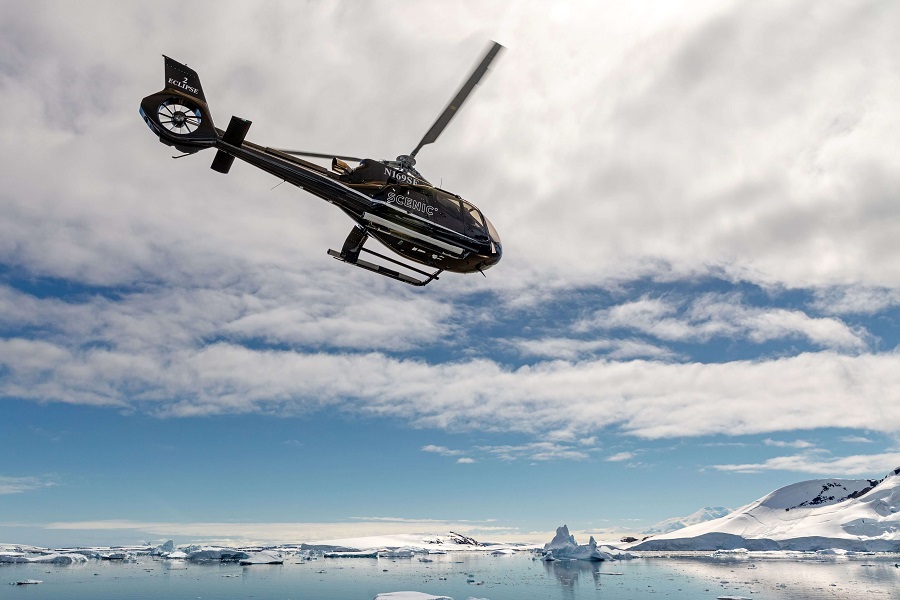
The best example of this, of course, is Mate Rimac and his phenomenal Rimac Automobili. In a country with no car industry whatsoever, a young man in his 20s started a business to realise his dream of building an electric supercar. So successful has Rimac been that not only has he now produced the world's fastest electric supercar, but he has also built a cutting edge technology business employing more than 600 people, with A-lister investors such as Porsche and Hyundai.

But away from the bright lights and column inches that the Rimac success demands these days, there are other many other Croatian success stories occurring under the radar. I had absolutely no idea, for example, that the German Minister of Economy had visited a warehouse in eastern Zagreb to learn about innovation in the workplace. Or that that same warehouse, operated by a small family business, Tokic car parts, had been listed in the top 50 most innovative companies in Europe by the London Stock Exchange. Read their incredible story here. Similarly, it was a pleasure to be in Berlin recently to see Bagatin Clinic collect the award for best international cosmetic surgery clinic at the International Medical Travel Journal 2019 awards, the latest endorsement of Croatia's emerging medical tourism industry.

But the last place I expected to find Croatian global excellence, having read recent news reports, was from the troubled Uljanik shipyard in Pula.
Don't get me wrong, Croatia has a fantastic shipbuilding heritage, and one which has provided much employment and built world-class vessels over the years. But the glory days seem to be over due to new economic realities, and the plight of the Uljanik shipyard was one of the main economic stories of 2019, a shipyard where orders had dried up and debts accrued.
But if you look a little deeper, you will find one of the most fantastic stories of Croatian success of last year, and one which has been little reported.
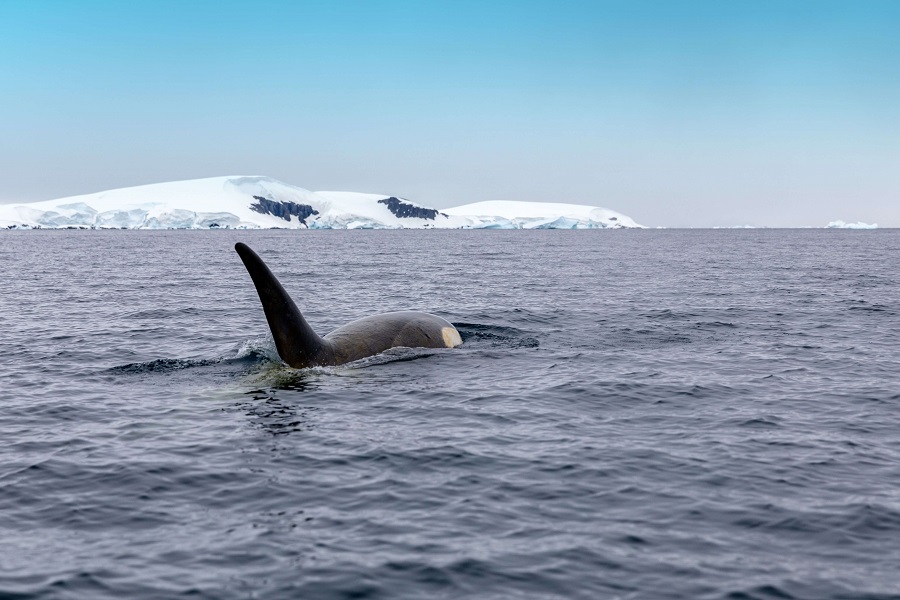
Not having paid more than cursory attention to the situation in the shipyard, I was somewhat surprised last July to see TCN reporting on a luxury 200-million-euro yacht called Scenic Eclipse being launched from Pula, destination Rejkavik, where it would pick up its first passengers for a new life of luxury Arctic and Antarctic cruises. Check out the gracious departure of Scenic Eclipse in the video below.
And there the story might have ended, except that I recently came across a list of awards for the cruise ship industry by leading industry website, Cruise Critic, in which Scenic Eclipse featured rather well - Best New Luxury Ship 2019.
Cruisers might book Scenic Eclipse because it offers two state-of-the-art helicopters and a six-person sub, but they'll come back because of the 200-passenger ship's chic, modern design, generously-sized suites and incredible dining offerings. Scenic pulled out all the stops with its first ocean ship, which seamlessly combines luxury and soft-adventure travel to exotic destinations, including the Arctic and Antarctica.

And the more I looked into this wondrous little ship, the more surprises I found along the way. The ship was christened in New York by none other than Dame Helen Mirren in New York in September.
So enthralled was Dame Helen that she has agreed to be the Godmother of the Scenic Eclipse, expressing her admiration both for the luxury on board and the attention paid to the environment in its construction, "a ship that has minimal environmental impact on sensitive marine areas and the eco-systems it sails."
And then when I decided to take a closer look at the ship itself, I made a rather interesting discovery. It seemed like the Scenic owners and the Pula shipyard had managed to produce the first of an entirely new category of ship - the discovery yacht, a polar cruiser that could explore parts of the planet no competition could visit. A little like Rimac, was Croatia contributing something unique and world-class yet again?
The ship is owned by the phenomenally successful cruise ship company, Scenic, whose company profile is summarised as:
Scenic Luxury Cruises and Tours has more than three decades of experience creating unforgettable handcrafted journeys for our guests with itineraries to more than 60 countries around the world. Scenic and its sister company, Evergreen Cruises and Tours are recognised as leaders in the industry.

Having seen a luxury private yacht in Sydney harbour one day, Scenic's Australian owners Glen and Karen Moroney apparently came up with the idea of offering all the luxury of a private yacht for cruise-paying passengers. A discovery yacht, smaller and more flexible than the normal cruise ship, allowing more personal guest attention and better flexibility and agility in routes and reaching destinations that the bigger ships simply could not go. And not just a discovery yacht, but a polar discovery yacht, capable of taking guests to parts of the Arctic and Antarctic that other ships simply cannot.
And toys. Lots of toys.
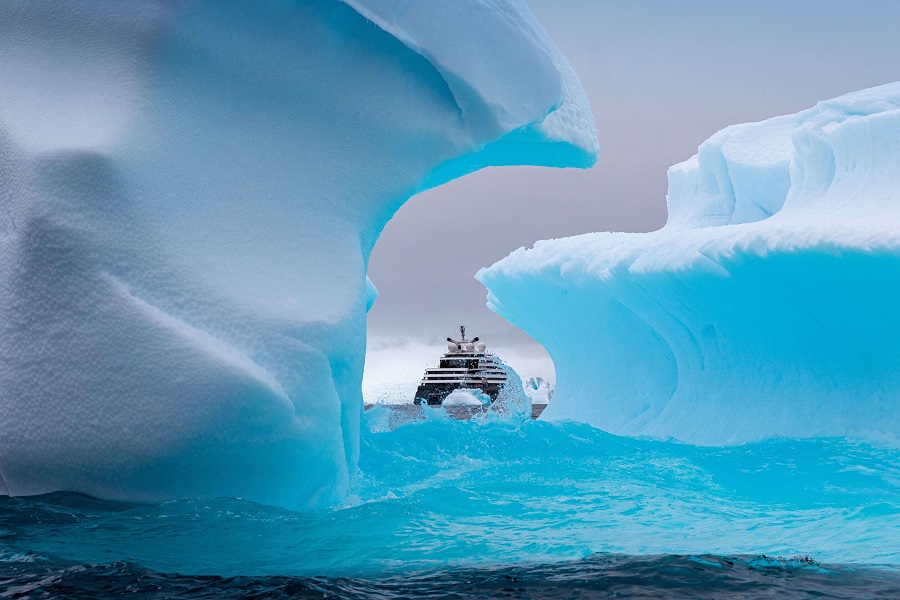
Where else would you find a cruise ship with its very own submarine, available to guests for excursions? A sophisticated sub with all the latest features that can take guests down to depths of 330 metres, including in some of the remotest parts of the planet during the Scenic Eclipse signature tours of the Arctic and Antarctic. As you can see in the US media story in the video below, the submarine skipper talks of some of the magical things he has seen, including jellyfish in the Arctic with tentacles about 15 metres long.
You can also check out an extended video interview with the submarine skipper, including some great footage.
Toys in the air - two helicopters available for sightseeing tours. Toys on the water - zodiac boats and kayaks, allowing guests to get up close. Rare sightings of leopard seals, and the chance to kayak in the Antarctic. How else would you get to experience a penguin flying out of the water and landing on your boat, observing the situation for a few minutes and then flipping back into the water? Experiences explained by the expert Scenic Eclipse guide in the video below.
One of the ironies I have always found with the cruise ship industry is that people travel to get away from it all to go and explore faraway places, then find themselves on a boat with several thousand people for at least a week. The Scenic Eclipse discovery yacht is an altogether different experience. As one would expect, the number of guests on board is considerably less (maximum 228) and the number of staff ratio much higher.
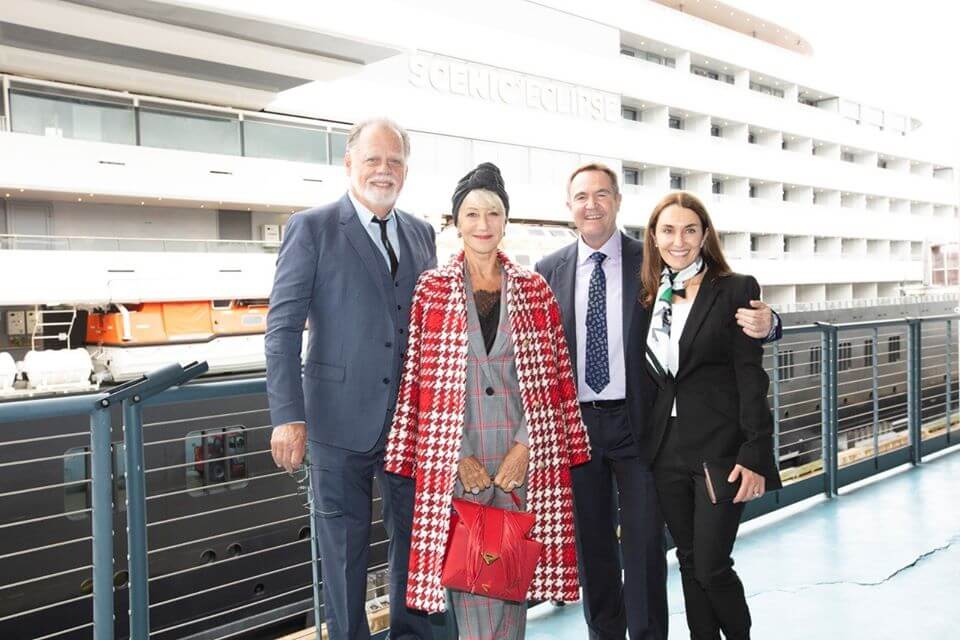
(Glen and Karen Moroney together with Dame Helen Mirren at the christening of Scenic Eclipse)
Glen and Karen Moroney were very much involved in the Scenic Eclipse project, having had that initial vision in Sydney Harbour. Glen was in charge of the overall design of the ship, while Karen - working with just two assistants - took care of the spectacular interior design.
Each suite comes with its own butler, and their spacious feel (the Owner's Suite is an impressive 195 m2) and luxury design gives a feel more of a presidential 5-star hotel suite than that of a yacht. There are ten venues on board, ranging from French to Japanese, with flavours and ingredients from all four corners of the planet, with an undoubted highlight being an invitation to Chef's Table, an exquisite dinner for a maximum of ten diners. No menu, diners are at the mercy of the creativity of the chef's kitchen. Early feedback suggests that the Chef's Table experience is not only the culinary highlight of the cruise, but among the top things on the entire cruise. An example of the range of quality on the wine, Champagne and spirits on offer can be gauged by the whiskey selection - sample one, or all, of the world's top 100 whiskeys while on your voyage.
A variety of beauty and health services are available to guests, such as the 600-square-foot Senses Spa Center featuring Scandinavian-style baths, a gym and Pilates studio and a hair salon.
Construction of Scenic Eclipse was far from straightforward. What was already a groundbreaking project was complicated by the bankruptcy problems at the Uljanik factory, which went bankrupt halfway through the ship's construction. Despite this, the Moroneys decided to continue to invest and - together with willing and skilled Croatian engineers and shipbuilders - Scenic Eclipse was completed in 2019. So happy are the owners with the ship that they have announced plans to build five more, all of them in Croatia.
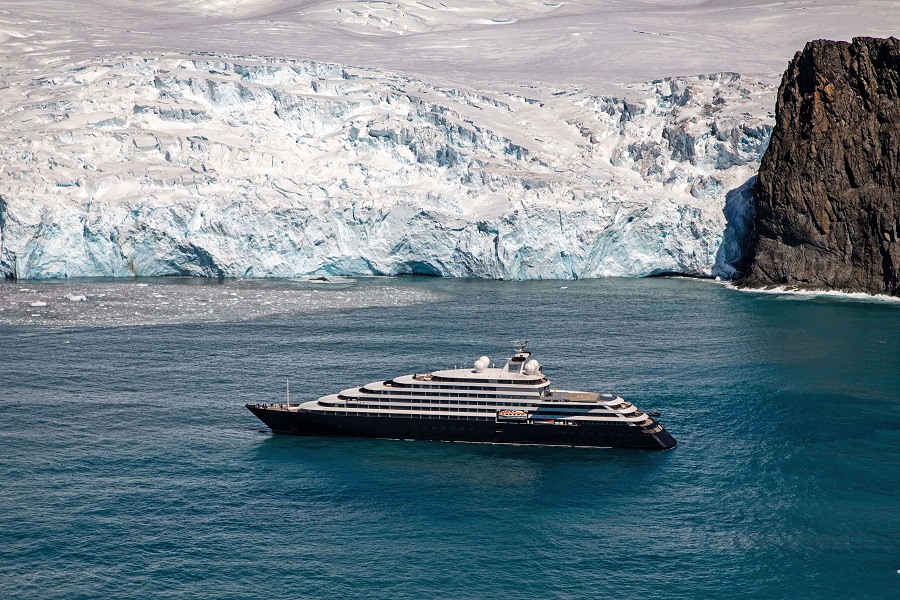
A great opportunity, perhaps, for Croatia to develop a new sector of excellence serving the global market, in the same way that Rimac Automobili does. Rimac has only actually built a handful of cars, but they are the very best on the market, with an appropriate price tag attached. Why can Croatia not repeat that success in the luxury discovery cruiser market, a market which was born in its shipyards?
“Despite the long tradition and the well-known skill of quality shipbuilding in Croatia, building this type of ship has been an incredible challenge for all of us involved in the construction. Scenic Eclipse proudly bears the label of a unique Croatian product in the world and offers its guests a special and cinematic "bonding" adventure experience. My wife and I are really proud that we had the opportunity to participate in the construction process ourselves, because for us this ship is much more than a business project. Scenic Eclipse is really a family project that we are very passionate about and we really care about, "said Scenic Group owner Glen Moroney.

Built for both Arctic and tropical waters, and with a flexibility due to its size that other cruise ships cannot offer, the Scenic Eclipse itinerary offers voyages like no other ship. Choose from Antarctica, South Georgia & the Falkland Islands; Europe & the Mediterranean; Norwegian Fjords & Baltic States; the Caribbean; the Arctic; and the Americas. Scenic Eclipse even visits the country of its birth, with Croatian stops in Rovinj, Hvar, Split and Dubrovnik.

The most popular tour on the Scenic Eclipse is the one from the Norwegian Svalbard Archipelago along the Greenland iceberg to Reykjavik. It is a 14-day trip that costs about $ 23,945 or HRK 160,000. The price includes plane tickets for arrival and return and nine meals on board, and 16 polar research experts who lead the tours and hold educational programmes with the guests. Longer Antarctic tours are much more expensive, so for example, a 19-day trip from Buenos Aires, around the Falkland Islands and the South Georgia Islands to the Antarctic Peninsula, where guests can enjoy views of whales and penguins, costs around $ 30,695 (HRK 200,000) for ordinary accommodation and almost half a million kuna for the Owner's Suite ($ 77,000).

A Mediterranean tour with Scenic Eclipse, from Barcelona, via Monte Carlo, sailing along the Italian coast to Santorini and all the way to Athens, guests will pay a minimum of $ 8,695 per person, or about HRK 57,000 for nine days. But it is actually the lowest price for off-season sailing with accommodation in the 32 m2 Verandah Suite cabin. Only the wealthiest who choose the Owner's Suite cabin, located on the sixth deck, will experience true exclusive accommodation. For a Mediterranean 9-day trip, the price of this cabin is $ 30,695 per person (HRK 200 thousand or HRK 22 thousand per day).
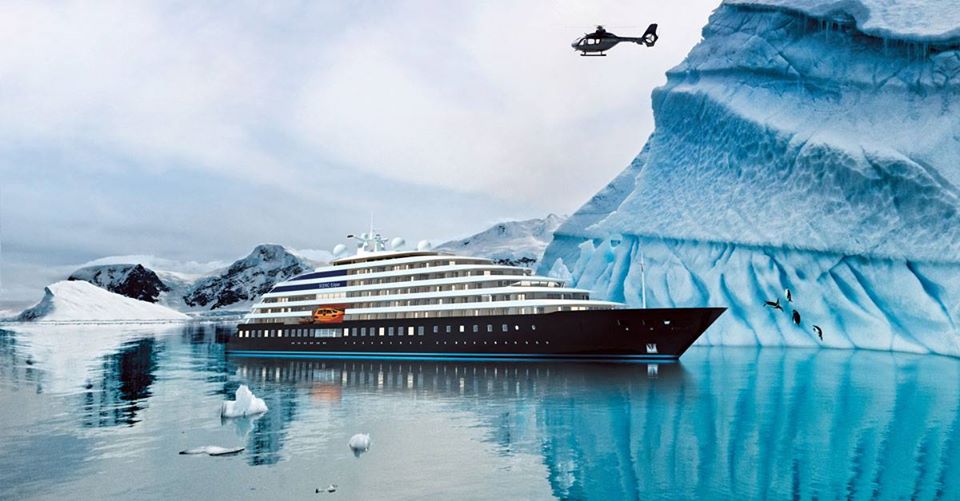
A luxury experience out of the budget of this correspondent, but how refreshing to once again scratch under the surface of Croatia and discover yet one example where it leads the world. And with the potential to deliver so much more to the Croatian economy, as well as luxury tourism worldwide.
Learn more about Scenic Eclipse on the official website.
Croatian Politics 2019: A Year in Review
What follows is a review of events in Croatian politics in 2019, as reported by TCN. If you would like to refresh your memory about the events which has led us here, read the reviews for the three previous years (2016, 2017, 2018).
The year started with a high-profile failure by the government. Months after it was announced that Croatia would buy used Israeli F-16 fighter planes, the US government vetoed the sale and the whole project fell through. Despite earlier warnings from experts that the deal was in question, ministers continued to claim that everything was alight. However, after a meeting between high-ranking officials from the United States and Israel, the truth was revealed. Ministers lost their nerves and the government launched an immediate investigation, which expectedly ended without any real results, and also announced that it would re-start the process. To show its level of seriousness, it even established a commission! Twelve months later, the process of deciding which aircraft to buy still hasn't move any further on and is not expected to end for at least another year.
The migrant crisis continued to be in the news this year. The inflow of migrants over the borders with Bosnia and Herzegovina and Serbia increased somewhat, together with media coverage about alleged brutality of Croatian police and illegal pushbacks of migrants to Bosnia. The authorities were quick to deny everything, but the sheer number of documented cases makes it apparent that at least some of the allegations are founded.
Efforts to limit media freedoms continued this year and some reporters were even briefly arrested. Journalists, NGOs and international organisations stood up to these attempts, but the final score is still unknown.
Repression continued in other ways as well, with courts ruling that peaceful protesters should go to prison, Croatia's human rights situation being criticised from abroad, ethnically-motivated assaults (several of them) taking place, ombudswomen’s warnings not being heard, journalists receiving instructions from the president on what to do, and diplomats spreading hate...
Historical revisionism was in full force once again this year. As a result, representatives of Jews, Serbs and anti-fascist organisations once again boycotted the government’s annual commemoration at the site of the Jasenovac concentration camp.
European elections were held in May (with even Pamela Anderson giving recommendations to Croatian voters). While the ruling HDZ party had high hopes earlier in the year (and was supported by German Chancellor Angela Merkel, who attended one of its rather controversial rallies in Zagreb), the actual results were much tighter and were interpreted by everyone as a success for the opposition (particularly SDP) and a disappointment for the government.
June brought us a few days of excitement when it seemed possible that prime minister Plenković might just succeed in his life-long dream of getting a top EU job. Despite denying he ever wanted such a thing, he was rumoured to be trying to become president of the European Commission (or president of the European Council, or perhaps something else). In the end, he had to return to Croatia empty handed, again denying his alleged attempts.
Unlike Plenković, foreign minister Marija Pejčinović-Burić was more successful in the area of career development. In June, she was elected secretary-general of the Council of Europe. She promptly resigned her post in Croatia and has not been heard about since. Another happy politician is Dubravka Šuica, who has been appointed Croatia’s commissioner in the European Commission.
Mostly good economic news continued. Public debt is at its lowest level in decades, the European Commission concluded that Croatia no longer suffered from excessive economic imbalances, and GDP growth is holding up.
One of the companies which was in the public focus this year was Croatia Airlines, Croatia’s national flag carrier. Its business results were dismal and the search for possible strategic partners was on, but without any real results. The government eventually decided to cover some of the debts, but as the year comes to and end, there is no long-term solution in sight. In the meantime, Zagreb Airport continues to lose airlines using its services.
The construction of an LNG terminal on the island of Krk has apparently started out with strong support from the US government, after many years of delays and announcements. The project is funded from the state budget, since there was no interest among anyone to actually use the terminal. The government claims that there will be interest once the terminal is built, but it would not be the first major government-funded project in Croatia’s history to fail to deliver on its promises.
The construction of Pelješac bridge continues to go at an even faster pace than expected (despite occasional Bosnian protests), mostly thanks to the efforts by the Chinese construction company which won the tender, which also brought about a marked improvement in the relations between Croatia and China. Unfortunately, the construction of the access roads leading up to the bridge has not progressed nearly as fast, with tenders being decided just several months ago. It is quite possible that, when the bridge is built, it will be unusable for a while because there will be no roads leading to it.
Emigration continues amid Croatia's demographic crisis, although somewhat slower than in previous years, probably as a result of the fact that most of those who could have left have already done so. The authorities talk about demographic revival, but nothing much has happened so far.
Political scandals were as numerous as ever. The regional development minister had an accident while driving without a driving license, the agriculture minister forgot to list all his assets on an official statement, the administration minister had his own scandals which were too numerous even to count, and the state assets minister had problems of his own. The Prime minister strongly supported his ministers before some of them resigned, and then he changed his mind and dismissed the rest of them.
The ruling coalition remained stable this year, despite occasional rumours of impending collapse. Ultimatums were rejected, resignations demanded, talks announced, decisions to stay in coalition made, threats given... Just the usual stuff.
As expected, the border dispute between Croatia and Slovenia has not been resolved this year. Slovenia was disappointed with the EU’s decision not to get involved in a dispute between its two members. The chances that this issue will feature in our review for 2020 are quite high.
In October, the European Commission announced that Croatia has fulfilled all the technical conditions to join the Schengen area. However, the final decision will require the unanimous support of all EU member states, and Slovenia does not seem ready to give its approval until the border dispute with Croatia is resolved.
Another major project is the introduction of euro in Croatia. After a lot of talk, the government has finally sent an official request. The process will certainly take years and opinion is divided as to whether it is a good idea or not.
One of the highlights were the trade union's activities. Earlier in the year, the unions managed to collect enough signatures for a referendum against the government’s pension reform and an increase in the retirement age. The government capitulated and revoked already approved laws (although it previously warned that such a decision would be a disaster).
The other major trade union success was the primary and secondary school strike later in the year. After almost two months, the government capitulated and gave the unions more or less everything they had asked for.
One of the highlights of the next six months will be Croatia’s EU presidency. The government is promoting it as a great success, although all EU member states sooner or later get their chance to hold the rotating presidency. While Croatia's plans are ambitious, their delivery will probably be more modest.
The major event at the end of the year was the first round of Croatia's presidential elections.
While the post is largely ceremonial, elections are held every five years and still manage to occupy public attention for months. Three major candidates launched their bids: incumbent president Kolinda Grabar-Kitarović (officially an independent candidate who in reality is HDZ), former SDP prime minister Zoran Milanović, and singer Miroslav Škoro, who presented himself as a candidate of change, despite having been an MP, a diplomat and a former HDZ member.
The first round was held on December 22. Zoran Milanović won with 29.6% of the vote, followed by Kolinda Grabar-Kitarović with 26.7%. Škoro was third with 24.5%. Milanović and Grabar-Kitarović will take part in the run-off on January 5.
Government Provides 3.Maj Shipyard with Guarantee for 26 Million Euro Loan
ZAGREB, September 19, 2019 - During its meeting on Thursday the government authorised the Finance Ministry to issue a government guarantee to the 3. Maj shipyard in Rijeka for a loan to be taken from the Croatian Bank for Reconstruction and Development (HBOR) and/or other commercial banks in the amount of 26 million euro in order to complete the construction of a ship at the dock.
Minister of Economy, Entrepreneurship and Crafts Darko Horvat underscored that the contracted price for a ship being constructed for the Algoma Central Corporation from Canada amounts to 33.36 million euro and that once the shipyard pays back 50 million kuna to HBOR to settle previous liabilities and repays the amount of this latest guarantee, the remainder of the revenue from the sale of the ship will be paid into the state budget.
Horvat added that the Jadranbrod - Croatian Shipbuilding Corporation has positively assessed that the contract with the Canadian client and that no risks have been identified in that contract.
Horvat addressed reporters ahead of the cabinet meeting and informed that there were still two ships at the Rijeka-based dock that will require government guarantees.
He explained that the completion of the two ships will need about 560 million kuna which will set the requirements for the shipyard to continue doing business in an orderly manner and contract new ships in that each state guarantee that is issued must be repaid after each ship is completed and delivered.
Prime Minister Andrej Plenković is travelling to Rijeka on Thursday afternoon and is expected to visit the dock.
More news about Croatia shipbuilding can be found in the Business section.
3. Maj Shipyard Workers Could Get Overdue Salaries Next Week
ZAGREB, September 5, 2019 - Economy Minister Darko Horvat said on Thursday the workers of the 3. Maj shipyard could get their first overdue salaries next week and that the dock's management last night signed a 36.6-million-dollar contract to build a ship for Canada's Algoma.
Speaking to the press ahead of a cabinet meeting, the minister said the payment of overdue salaries would be preceded by an agreement the dock and the Croatian Shipbuilding Corporation - Jadranbrod (HB-J) company were expected to sign early next week.
He recalled that a majority of creditors had agreed to the payment of 15% of their claims from a new loan taken by 3. Maj and to a two-year deferral for the remaining 85%, after which the Croatian Bank for Reconstruction and Development green-lighted the approval of 150 million kuna loan in line with a government decision to give the dock a conditional state guarantee.
For the process to be launched, HB-J, which will monitor the money transfer, and 3. Maj, which will receive the money, need to sign an agreement, Horvat said, adding that the payment of the said 15% was a prerequisite for unfreezing 3. Maj's account, putting it back into operation and finding a strategic partner.
Asked if taxpayers would again pay for shipbuilding, he said they would not. "All the money we set aside for completing ships in (3. Maj) will be returned into the budget and the €5 billion we projected in revenue will stay in 3. Maj's account."
More news about Croatian shipbuilding industry can be found in the Business section.
Agreements for 82% of 3. Maj Shipyard's Debts Signed
ZAGREB, September 2, 2019 - Rijeka's 3. Maj shipyard has signed agreements with suppliers and sub-contractors to defer the majority of its debts or approximately 111 million kuna, which is about 82% of all claims by creditors, so we believe that we have met the government's first condition, the chair of the shipyard's supervisory board, Juraj Šoljić, told Hina on Monday.
Šoljić said that the shipyard's total debt amounted to 138 million kuna, excluding overdue wages and contributions on wages of 34 million kuna, adding that he expected more agreements to arrive by post.
"Without pre-empting the Finance Ministry's decision, we at 3. Maj consider that we have met the government's first condition," Šoljić underscored.
He confirmed that the national electricity provider HEP, which is one of the largest creditors, had signed an agreement to delay 85% of its dues for a period of 2 years while the remaining 15% would be paid to creditors from a new loan to the shipyard. He added that other state institutions had done the same.
Last month the government approved the issuance of a conditional payment guarantee in the amount of 150 million kuna for a loan from the Croatian Bank for Reconstruction and Development in an effort to re-launch production so that ships that have been started at the shipyard can be completed.
The finance ministry will issue the conditional guarantee provided that the requirements for that have been met by September 5.
One of the main requirements is for creditors to agree to accept a payment of 15% of their claims immediately while agreeing not to block the shipyard's bank account for the next two years.
A hearing at Rijeka Commercial Court to determine whether conditions exist to launch bankruptcy proceedings for the shipyard has been adjourned several times, and the next hearing has been set for September 26. In the meantime, the Economy Ministry was obliged by August 29 to define a financial model and other conditions to relaunch production.
A model was to be found that would ensure unfreezing the shipyard's account, to pay workers their overdue wages and to define the completion and payment of incomplete ships with clients.
More news about Croatian shipbuilding industry can be found in the Business section.
Unions Expect Production at 3. Maj Shipyard to Start as Soon as Possible
ZAGREB, August 23, 2019 - Union leader at the Rijeka-based 3. Maj shipyard, Juraj Šoljić on Thursday said that preparations were already being made to launch production at the dock which is something workers are hoping will occur as soon as possible.
Šoljić added that workers also expected to be paid nine outstanding wages as soon as possible.
He appealed on the Finance Ministry to start paying wages and other activities so that production could commence.
Šoljić added that Edi Kučan would remain as the director of the dock and that the Supervisory Board had extended his term for open ended period.
Asked about a new bail out for the dock, Šoljić said that they were aware that the shipyard could not remain to be under state ownership.
"This is an opportunity for 3. Maj to find a new strategic partner in the next two years that will seriously enter into 3. Maj and be involved in ship building. We have a lot of support from the Economy Ministry in that regard and the judiciary and Prime Minister Andrej Plenković.
There are about 700 workers currently at the dock and the union considers that they are sufficient to launch production and if necessary, to engage sub-contractors.
Earlier in the day the government decided to allow the issuance of a conditional payment guarantee in the amount of 150 million kuna to the Rijeka-based 3. Maj shipyard.
Prime Minister Andrej Plenković said that finance-wise that meant that the guarantee would not cause any additional costs for the government and that it will make it possible for the dock to complete the ships already under construction at the dock.
More news about Croatian shipyards can be found in the Business section.
Conditional Guarantee for 3. Maj Shipyard Approved
ZAGREB, August 22, 2019 - The Croatian government on Thursday decided to allow the issuance of a conditional payment guarantee in the amount of 150 million kuna to the Rijeka-based 3.Maj shipyard.
Prime Minister Andrej Plenković said that finance-wise it meant that the guarantee would not cause additional costs for the government and it will make it possible for the dock to complete the ships under construction.
The future of that shipyard also creates, to some extent, prospects for Uljanik to continue doing business, Plenković said at the government's meeting.
The intention of this government is to find a strategic partner for 3. Maj, he reiterated.
Plenković recalled that in early August he visited the dock in Rijeka and that he had been informed by the dock's management about the current state of affairs and the future plans. On that occasion the premier said that all what he heard during the talks was encouraging. "Our engagement is intended to help solve the urgent problems now, and in two years' time how long the completion of the ships will take, the survival of shipbuilding in 3.Maj should be enabled, with a strategic partner being found," Plenković said then.
Coming to today's meeting of the cabinet, Economy Minister Darko Horvat said that the purpose of the issuance of the conditional guarantee to the 3.Maj dock would be to help the company to deliver the ships under construction in a timely fashion.
He also said that there were investors who showed interested in the Rijeka-based company.
The finance ministry is due to issue the conditional guarantee only if the necessary conditions are met for that move until 5 September.
More news about the shipbuilding industry can be found in the Business section.
3. Maj Shipyard Wants Creditors to Put on Hold 85% of Their Claims
ZAGREB, August 13, 2019 - The director of the 3. Maj shipyard, Edi Kučan, confirmed to Hina on Tuesday that the management of that Rijeka-based dock would today offer its creditors to sign statements whereby they would accept the payment of 15% of their claims from the dock right away while agreeing not to block the dock's bank account for the next two years over the remaining claims.
This model was proposed to creditors by Assistant Economy Minister Zvonimir Novak at a meeting held in Rijeka on Monday.
According to Novak, the creditors would sign statements whereby they would agree to put on hold most of their claims from the shipyard in the next two years, and the government would in return make a decision to pay the creditors 15% of the amount the shipyard owes them.
Kučan expects the creditors to accept the deal, noting that the meeting was held in good faith.
He is optimistic about 3. Maj resuming production, with two of the preconditions for that being the unblocking of the company's account and the postponement of payment of a part of creditors' claims in the coming period.
Putting on hold the payment of 85% of claims from the shipyard would make it possible for the company to resume production and continue work on vessels whose construction has already begun.
The bank account of 3. Maj, which is part of the ailing Uljanik shipbuilding group, has been blocked over claims in the amount of slightly under 80 million kuna, and the biggest individual creditors are the Finance Ministry and the HEP power provider.
More news about the shipbuilding industry can be found in the Business section.
Bošnjaković: Government Willing to Help 3. Maj Shipyard
ZAGREB, August 7, 2019 - Justice Minister Dražen Bošnjaković said on Tuesday that the government had shown its willingness to help the Rijeka-based 3.Maj shipyard last week when it decided to get involved in efforts to help this ailing company.
"The company's account was blocked due to debts in the amount of more than 150 million kuna. The management has manged to resolve nearly a half of that amount, it has reached agreement with creditors to withdraw their claims. The blockade now refers to some 86 million kuna in receivables. Now it is necessary to ensure funds to deal with that amount and there are several models for that," Bošnjaković said in an interview with the RTL commercial broadcaster.
He explained that after the government expressed its readiness to get involved in efforts to salvage the company, the dock should now agree with clients on the completion of the ships under construction.
The minister also said that it was important for the government to have options to cover the guarantees in case of their enforcement so that it would not be a burden for tax payers.
The money for that purpose could be secured through the sale of the commissioned ships, Bošnjaković added.
"It is necessary to find the best model to resolve the debts towards workers and creditors, and this is the first step paving the way for the future course which includes talks with the clients, ships' sale and the comprehensive stabilisation as well as finding a strategic partner," the minister said after earlier in the day, Prime Minister Andrej Plenković, accompanied by a few cabinet ministers, including him, visited the dock for the talks with the management on how to help the company.
The government will do all it can to help Uljanik, however, the situation in that Pula-based shipyard is completely different, according to Bošnjaković 's explanation.
The clients have shown interest in the completion of the ships under construction in 3.Maj, while clients of Uljanik have cancelled all agreements, according to the minister's explanation.
More news about Croatian shipyards can be found in the Business section.


